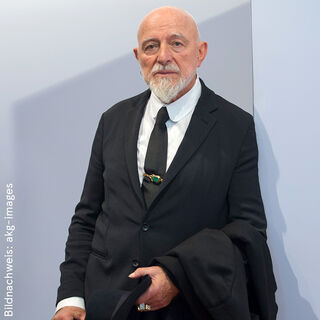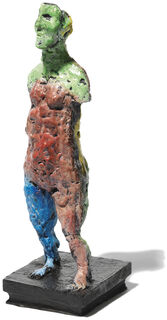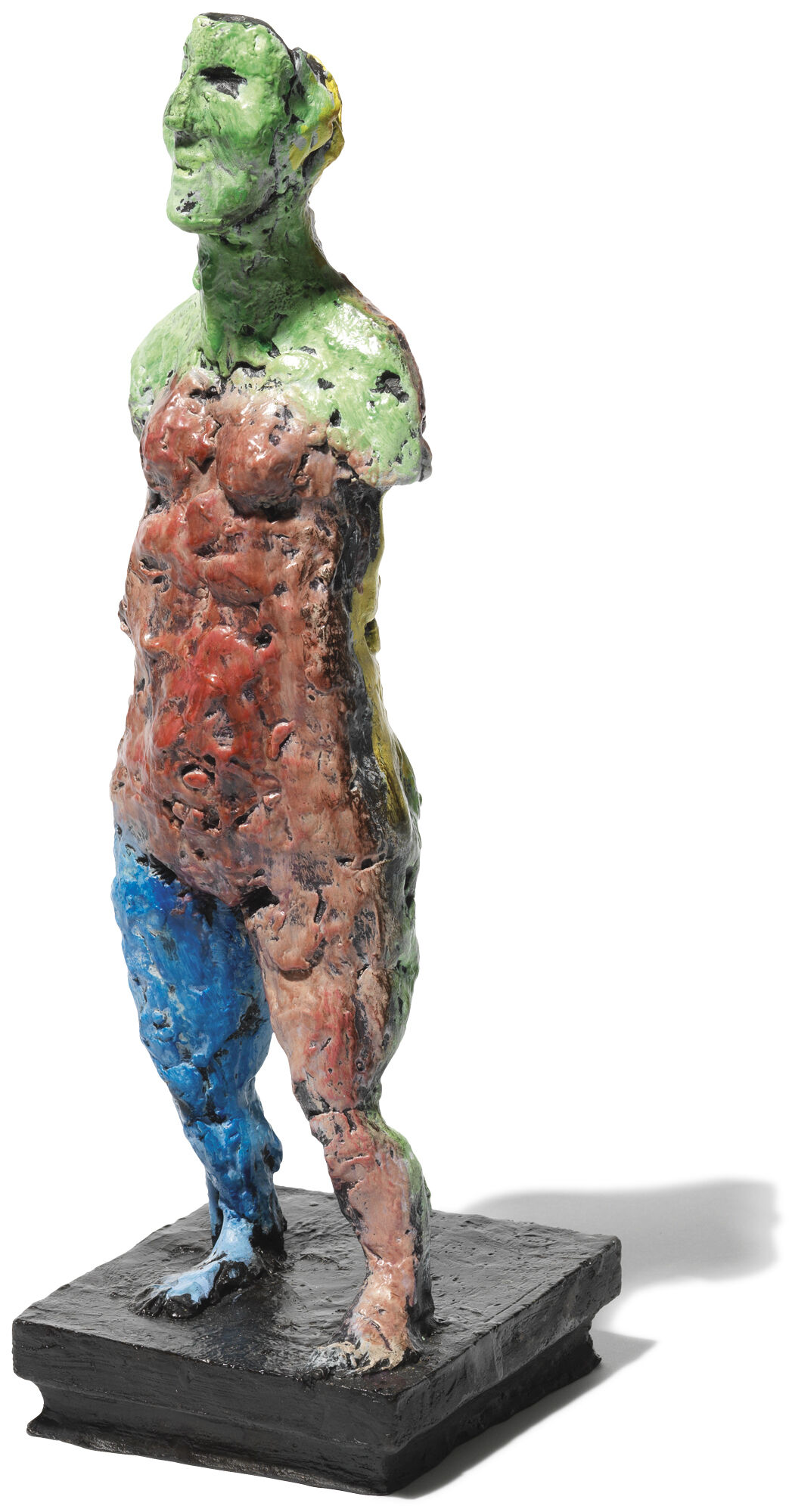Sculpture "Susanna" (2015)
Sculpture "Susanna" (2015)
Quick info
limited, 45 copies | numbered | monogrammed | stamped | hand-painted | bronze | size 48 x 16.5 x 14.5 cm (h x w x d)
Detailed description
Sculpture "Susanna" (2015)
Solid bronze sculpture, 2015. 45 copies, hand-painted, numbered, monogrammed and stamped. Height: 48 cm, width: 16.5 cm, depth: 14.5 cm.

About Markus Lüpertz
Markus Lüpertz, geb. 1941 in Reichenberg in Böhmen, ist als exzentrischer Malerfürst bekannt. Die internationale Anerkennung erntet er jedoch für sein Kunstschaffen. In seinem umfangreichen Œuvre wechseln sich gegenständliche und abstrakte Werkphasen ab.
In den 60er und 70er Jahren entstanden die "dithyrambischen" Werke, deren stilistische Merkmale vor allem Pathos, Theatralik und klassizierende Komponenten sind. Besonders in den 80er Jahren paraphrasiert Lüpertz Werke des Klassizisten Nicolas Poussin. Wieder einen neuen Werkabschnitt kann man in den 90er Jahren ausmachen. Die Bibel und Sagen werden nun nicht nur in Gemälden sondern auch in der Skulptur zum Thema. Hier geht es ihm um elementare Emotionen des Menschen wie Einsamkeit oder Versagen.
Seinen Platz in der Welt fordert Markus Lüpertz mit wenigen Worten ein: "es gibt kein mittel gegen mich ich bin wie der regen ich bringe euch die blumen zum blühen, die erde zum atmen, die welt in euch erträglich zu finden. Freut euch, denn ich habe die angst hütet euch vor meinen bildern hängt sie ab dreht sie mit dem gesicht zur wand aber ich bitte euch, laßt mich leben."
Nach dem Kunststudium 1956-61 in Krefeld und Düsseldorf siedelte er nach Berlin um. Mit seiner figurativen Malerei wird er zu den "Jungen Wilden" gezählt, die in den 60er Jahren das abstrakte Informell ablösten. So reduzieren sich seine Motive oftmals auf einzelne Gegenstände, die er monumental in Szene setzt.
Markus Lüpertz unterrichtete an der Staatlichen Kunstakademie in Düsseldorf. Als deren Rektor war er von 1988 bis 2009 Nachfolger von Joseph Beuys.
Der Künstler lebt und arbeitet heute in Berlin, Düsseldorf und Karlsruhe. Seine Werke finden sich weltweit in vielen führenden Sammlungen und Museen der modernen Kunst wieder. Die Werke von Markus Lüpertz sind gesucht und i.d.R. schnell vergriffen. Sie besitzen ausgezeichnete Aussichten für eine dynamische Wertentwicklung.
Im Frühjahr 2015 richtete das Musée d'Art Moderne de la Ville de Paris Lüpertz eine umfangreiche Retrospektive aus, die die internationale Relevanz des Künstlers bestärkt hat.
An alloy of copper with other metals (especially with tin) used since ancient times.
When casting bronze, the artist usually applies the lost-wax technique which is dating back more than 5000 years. It's the best, but also the most complex method of producing sculptures.
First, the artist forms a model of his sculpture. It is embedded in a liquid silicone rubber mass. Once the material has solidified, the model is cut out. The liquid wax is poured into the negative mould. After cooling down, the wax cast is removed from the mould, provided with sprues and dipped into ceramic mass. The ceramic mass is hardened in a kiln, whereby the wax flows out (lost mould).
Now we finally have the negative form, into which the 1400° C hot molten bronze is poured. After the bronze had cooled down, the ceramic shell is broken off and the sculpture is revealed.
Now the sprues are removed, the surfaces are polished, patinated and numbered by the artist himself or, to his specifications, by a specialist. Thus, each casting becomes an original work.
For lower-quality bronze castings, the sand casting method is often used which, however, does not achieve the results of a more complex lost-wax technique in terms of surface characteristics and quality.
Term for an art object (sculpture, installation), which is produced in multiple copies in a limited and numbered edition according to the artist‘s will.
Artist's multiples have been called the most accessible and affordable art on the market.
A plastic work of sculptural art made of wood, stone, ivory, bronze or other metals.
While sculptures from wood, ivory or stone are made directly from the block of material, in bronze casting a working model is prepared at first. Usually, it is made of clay or other easily mouldable materials.
The prime time of sculpture after the Greek and Roman antiquity was the Renaissance. Impressionism gave a new impulse to the sculptural arts. Contemporary artists such as Jorg Immendorf, Andora, and Markus Lupertz also enriched sculptures with outstanding works.


